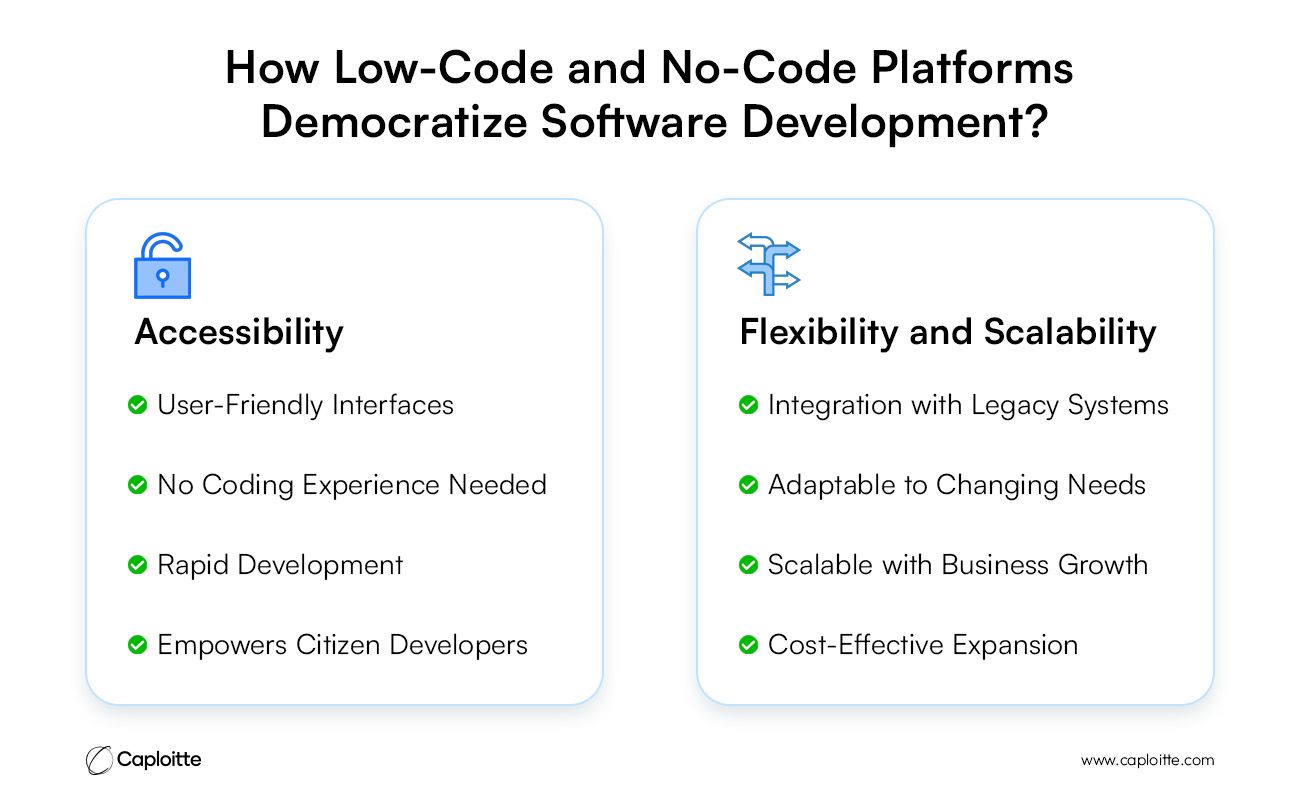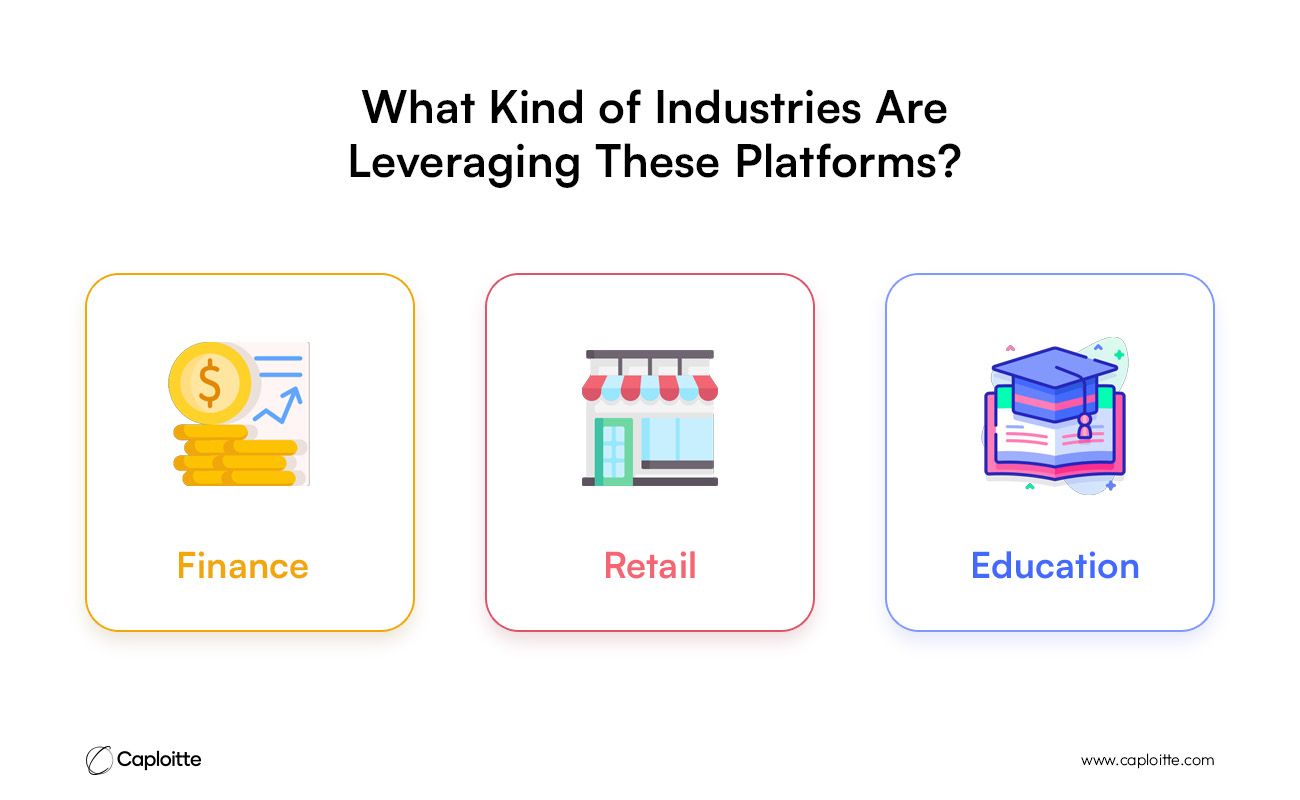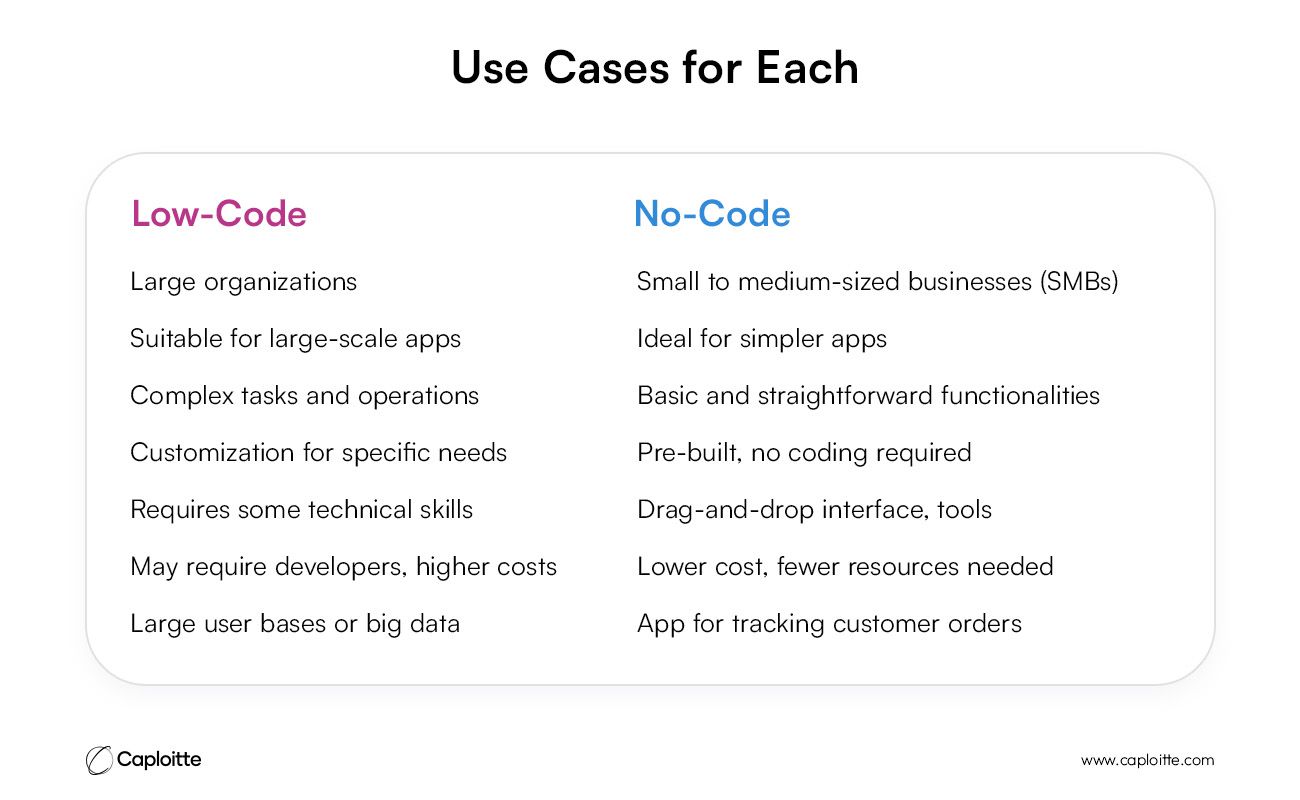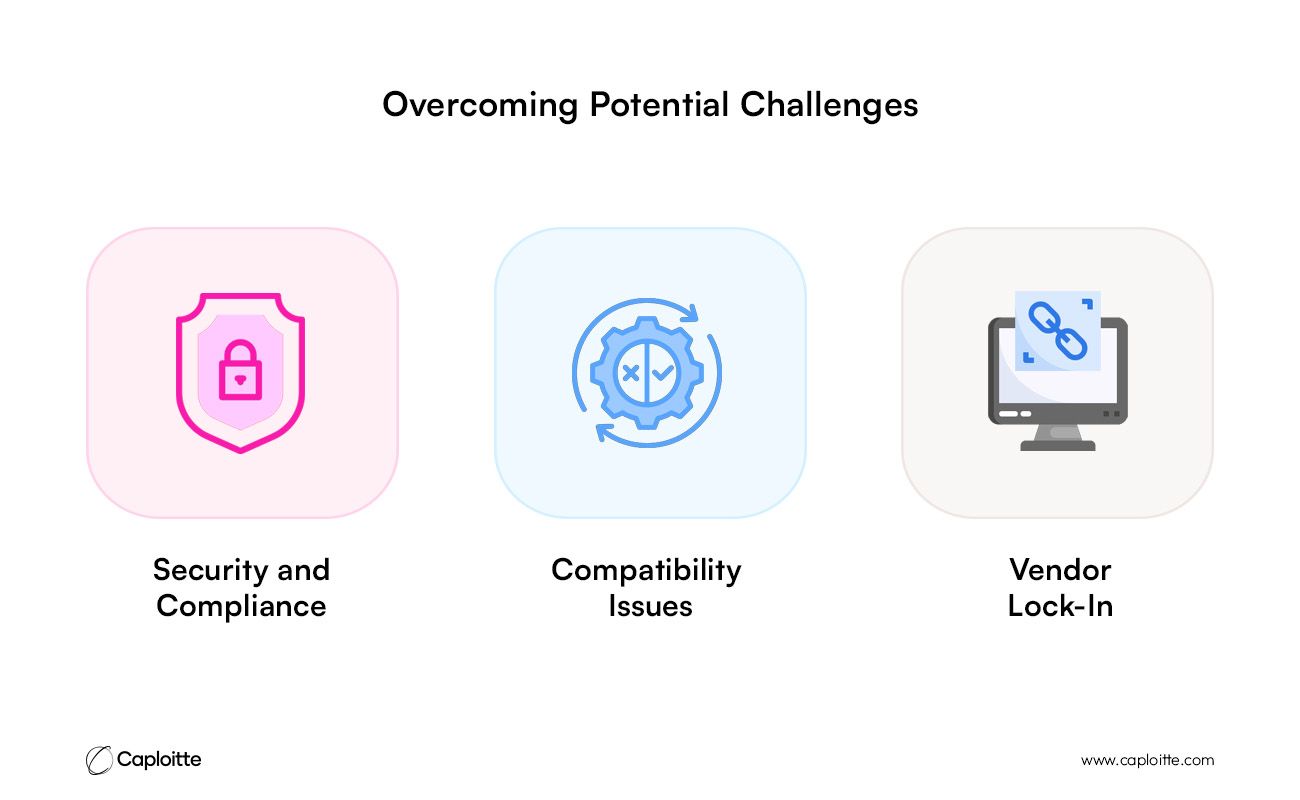The Rise of Low-Code and No-Code Development: What It Means for Your Business
-
Caploitte
-
22 Oct 2024
-
09 Min Read
The Traditional Software Development Bottleneck
Key Differences Between Low-Code and No-Code Platforms
The world of software development is moving quicker than ever. Low-code and no-code platforms are leading this trend. These platforms are altering how firms construct custom applications. Companies no longer need massive teams of developers. Instead, these technologies allow practically anyone to design apps with little or no coding skills. This article will discuss how low-code and no-code platforms are democratizing software development. We will also look at how firms may build solutions rapidly and cost-effectively using these platforms.Key topics will discuss the benefits, obstacles, and future trends defining this fascinating transformation.
The Traditional Software Development Bottleneck

Traditional software development is a long and involved process. It requires talented developers who spend months, often years, developing programs from scratch. The process typically starts with requirement analysis, followed by design, implementation, testing, deployment, and continuous maintenance. Each of these stages takes enormous resources, both in time and money. Due to its intricacy, traditional coding has long been a domain reserved to highly skilled specialists. This strategy is not only time-consuming but also expensive. Businesses must commit considerable sums to maintain a development team and infrastructure. As a result, many companies encounter delays in getting their products to market.
High Costs
The cost of traditional software development can be staggering. Hiring qualified developers and setting up the appropriate infrastructure often demands big financial commitments. Additionally, companies need to budget for regular maintenance. Security issues, bug repairs, and new feature requests all add to the cost. Traditional development involves regular attention to ensure programs work smoothly.
Long Development Cycles
Traditional development utilizes a waterfall approach. This strategy includes completing one stage before going on to the next. It produces lengthy development cycles and delays in responding to market developments. With this rigid structure, teams cannot quickly adjust to feedback or altering business needs. The outcome is often a delayed time-to-market, causing organizations to miss opportunities and incur competitive disadvantages.
Maintenance and Update
Once an application is live, the job is far from over. Traditional software demands regular upgrades and maintenance to correct bugs, improve security, and introduce new features. This method often causes a backlog of maintenance duties. Additionally, every upgrade can expose new security vulnerabilities, which require rapid attention. The ongoing need for upgrades and security measures becomes a big drain on resources, slowing down the business’s capacity to develop.
Introduction to Low-Code and No-Code Platforms

Definition: Low-code platforms offer a mechanism to construct applications with little coding.They contain visual tools, such drag-and-drop functionalities, but also allow developers to add custom code for extra control. No-code platforms go this farther. They are totally visual, meaning users need no coding skills. These platforms are built for business users, commonly termed citizen developers, who can create apps without having aid from the IT team.
Evolution: Low-code and no-code platforms have grown significantly in response to a need for speedier digital transformation. With organizations shifting more processes online and the emergence of cloud computing, these platforms have changed from being basic tools to becoming important settings for application development. They now allow organizations to construct sophisticated apps with ease, letting them adjust fast to market changes.
How Low-Code and No-Code Platforms Democratize Software Development?

Low-code and no-code platforms are redefining how firms produce software. These
technologies allow people to construct applications without needing to write sophisticated code.This move allows more people to take part in software development. Before, software creation was only done by professional developers. The process was slow and costly. Now, low-code and no-code platforms make development faster and cheaper. They give drag-and-drop tools and templates. This simplifies the process, enabling firms satisfy client needs quicker. It also helps boost efficiency across departments.
Accessibility
Low-code and no-code platforms give authority to business users and non-technical workers.These people, known as citizen developers, can construct applications on their own. They do not need to rely on IT departments for fundamental software. With easy-to-use interfaces,anyone can design apps without coding skills. This allows organizations to develop faster.Instead of waiting months for IT, teams may design tools within days. This saves delays and allows companies move swiftly to remedy problems.
Flexibility and Scalability
These platforms are also adaptable and scalable. They can link with older technologies that firms already employ. This means firms don’t have to replace their software. They can add additional features or applications as needed. As companies grow, these platforms may grow with them. The tools can manage more users or sophisticated activities without having a complete rewrite. This makes low-code and no-code solutions a reasonable choice for long-term use. Businesses can continue to grow without worrying about outgrowing their tools.
What Kind of Industries Are Leveraging These Platforms?

Healthcare: Healthcare professionals are using these platforms for patient management, telemedicine, and administrative chores. Hospitals can design applications to organize visits or maintain medical records. These solutions make it easier for doctors to connect with patients remotely through telemedicine.
Finance: The finance industry employs these platforms for fraud detection, compliance, and
customer service. Banks design apps to meet legal requirements and give better service. These
tools let banks adapt swiftly to new rules or market shifts.
Retail: Retailers employ low-code and no-code tools for inventory management and
e-commerce. These tools help stores track their inventories and automate sales operations.
Retailers can build better consumer experiences using these tools.
Education: Schools and universities use these platforms to construct online learning systems.
They also use them for maintaining student information and executing administrative
responsibilities. These solutions enable educational institutions provide better services to
students and manage their operations more efficiently.
Key Differences Between Low-Code and No-Code Platforms
Low-code and no-code platforms share the goal of simplifying software development. However, they range in their levels of personalization and intricacy. These distinctions affect how organizations use them and what kind of apps they can produce.
1. Customization & Complexity

Low-code: Low-code platforms allow consumers more flexibility. They allow for some coding, which means developers may create new features. This is critical for firms that need specific tools or advanced business logic. For example, firms that require complicated operations can employ low-code to personalize their systems. These platforms are perfect for building detailed and scalable apps.
No-code: No-code systems, on the other hand, emphasis on simplicity. They are created for folks who don’t know how to code. No-code platforms give ready-made tools that users can drag and drop to construct apps. This makes them easy to use, but it restricts the degree of personalization. Businesses can still design strong programs, but they might not be able to fine-tune them as much as with low-code platforms. In short, no-code is ideal for rapid and easyapp creation, but it might not manage more complicated needs
2. Use Cases for Each

The diverse features of low-code and no-code platforms make them suited for different sorts of businesses.
Low-Code: Large organizations frequently favor low-code platforms. These companies need to design apps that are scalable and able to handle complex tasks. For example, a corporation may need unique software for handling a huge number of people or processing big data. Low-code platforms allow organizations to design apps that match their particular demands while yet being easy to produce.
No-Code: Small to medium-sized enterprises (SMBs) commonly prefer no-code platforms. These platforms are perfect for firms who want to create apps rapidly and don’t need complicated functionality. For example, a small business might use a no-code platform to construct an app for tracking customer orders. The firm doesn’t need coding expertise, and they can have the app ready in a short amount of time. No-code platforms are also great for firms that wish to cut expenses and avoid hiring specialized engineers
Benefits of Low-Code and No-Code Platforms for Businesses

Cost Efficiency
Low-code and no-code platforms help businesses save money. They eliminate the requirement for employing competent developers, which saves labor expenses. Instead of designing everything from scratch, organizations may use simple tools to create apps rapidly. This implies corporations don’t have to pay exorbitant compensation for specialized teams. Additionally, these platforms commonly use subscription structures. This decreases the initial expenditure needed, as firms pay a recurring fee rather than big upfront fees. As a result, businesses can save both time and money.
Speed and Agility
One of the main advantages of low-code and no-code platforms is speed. Businesses may construct apps considerably faster by employing pre-built components. Instead of writing code, users drag and drop items to create complete programs. This shortens development cycles, allowing enterprises to get their apps up and running quickly. Moreover, if company demands change, adjustments can be done in real time. Businesses may easily make improvements based on feedback without needing to start from scratch. This agility allows organizations to stay ahead of competition
Enhanced Collaboration
Low-code and no-code platforms enable improved teamwork between business and IT teams. Since these platforms are user-friendly, non-technical staff can get part in the development process. This allows business users to communicate their demands directly, and IT can focus on the technical aspect. By working collaboratively, teams can verify that apps correspond with company goals. This collaboration speeds up development and leads to more inventive
solutions. The outcome is fewer delays and a smoother process.
Reduced Strain on IT Departments
With low-code and no-code platforms, IT personnel no longer need to manage every minor activity. Business users may now design simpler apps on their own, decreasing the strain for IT. This permits IT teams to focus on more sophisticated and significant initiatives. Instead of repairing minor flaws, they can concentrate on enhancing the company’s entire technical infrastructure. This balance makes IT teams more efficient while empowering business users to contribute to app development.
Overcoming Potential Challenges

Security and Compliance
One of the primary challenges with low-code and no-code platforms is security. When non-technical users create apps, there is a risk of security flaws. These users may not have the same grasp of data protection as professional developers. To address this issue, platform governance is necessary. Businesses should verify the platform has strong security features, such as data encryption. Compliance solutions, including those for GDPR and HIPAA, are critical for protecting sensitive information. By using these technologies, organizations can keep their apps safe while maintaining inside regulatory constraints
Compatibility Issues
Integrating low-code and no-code apps with existing systems can be hard. Many companies currently utilize complex software and databases. Ensuring that new low-code or no-code apps run smoothly with these systems is critical. Sometimes, certain platforms may not offer full compatibility. To avoid complications, organizations should test how effectively the new app will operate with their present software. Proper planning and integration support are crucial to ensuring that everything performs together without disturbing operations.
Vendor Lock-In
Another difficulty firms confront is vendor lock-in. This happens when a company becomesoverly dependent on one platform. If the platform changes or stops being supported, it can be tough to switch to a new one. To prevent this, firms should carefully analyze the long-term adaptability of the platform. It’s crucial to choose a platform that facilitates quick migration if needed. Businesses should also assess whether the platform corresponds with their long-term ambitions, so they are not stuck with limited options in the future.
Conclusion
Low-code and no-code platforms are redefining how organizations approach software development. By simplifying the process, these platforms allow more users to create applications without needing sophisticated coding abilities. This move democratizes technology,making it available to a wider audience. It encourages non-technical people to participate in innovation, resulting to speedier and more efficient solutions.
For businesses, embracing these platforms is vital for staying competitive. They enable rapid development, decrease expenses, and allow for quick modifications. The flexibility of low-code and no-code platforms facilitates long-term growth, delivering scalable solutions. Companies that use these technologies can respond faster to market demands while minimizing the pressure on IT workers. Overall, low-code and no-code platforms are vital for businesses trying to innovate, minimize expenses, and stay ahead in a fast-paced digital world.
